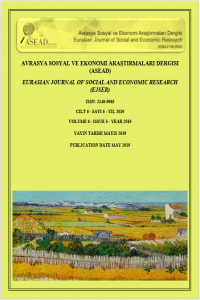THE RELATIONSHIP BETWEEN THE CHOICE OF GLOBAL EXPANSION STRATEGY AND MARKET ORIENTATION THROUGH ORGANIZATIONAL LEARNING PERSPECTIVE
Öz
As organizations mature and grow, one of the best growth options would be to expand
operations globally. While the choice of enter into foreign waters includes exporting,
franchising, licensing, joint ventures and wholly owned subsidiaries, options for wholly
owned subsidiaries may involve starting-up a completely new operation (greenfield
investment) and acquiring a host-country company (acquisition). On the other hand, market
orientation points out organization wide generation of market intelligence, and gain more
value in today’s business world. Similarly, in order to keep pace with changing competitive
conditions, organizational learning becomes popular among organizations. Choosing the
learning mode suitable for the organization should depend on market-orientation and the
choice of global expansion strategy.. Different choices indicate different requirements for
knowledge acquisition. Relying on these arguments, this study offers a factorial model to
deduce learning modes of organizations according to their market orientation levels (highlow)
and the choice of entry strategies (greenfield investments-acquisitions).
Anahtar Kelimeler
Organizational Learning Market Orientation Global Expansion Strategy
Kaynakça
- Baker, W. E., & Sinkula, J. M. (1999). The synergistic effect of market orientation and learning orientation on organizational performance. Journal of the Academy of Marketing Science, 27(4), 411-427. Bapuji, H., & Crossan, M. (2004). From questions to answers: reviewing organizational learning research. Management Learning, 35(4), 397-417. Barkema, H. G., & Vermeulen, F. (1998). International expansion through start-up or acquisition: A learning perspective. Academy of Management Journal,41(1), 7-26. Calantone, R. J., Cavusgil, S. T., & Zhao, Y. (2002). Learning orientation, firm innovation capability, and firm performance. Industrial Marketing Management,31(6), 515-524. Garvin, D. A. (1993). Building a learning organization. Harvard Business Review, July-August, 78-91. Harvey, C., & Denton, J. (1999). To come of age: the antecedents of organizational learning. Journal of Management Studies, 36(7), 897-918. Hill, C. W., & Jones, G. R. (2008). Strategic Management: An Integrated Approach. Cengage Learning. Huber, G. P. (1991). Organizational learning: the contributing processes and the literatures. Organization Science, 2(1), 88-115. Hurley, R. F., & Hult, G. T. M. (1998). Innovation, market orientation, and organizational learning: an integration and empirical examination. The Journal of Marketing, 42-54. Jaworski, B. J., & Kohli, A. K. (1993). Market orientation: antecedents and consequences. The Journal of Marketing, 53-70. Keskin, H. (2006). Market orientation, learning orientation, and innovation capabilities in SMEs: An extended model. European Journal of Innovation Management, 9(4), 396-417. Kohli, A. K., & Jaworski, B. J. (1990). Market orientation: the construct, research propositions, and managerial implications. The Journal of Marketing, 54, 1-18. Lane, P. J., & Lubatkin, M. (1998). Relative absorptive capacity and interorganizational learning. Strategic Management Journal, 19(5), 461-477. March, J. G. (1991). Exploration and exploitation in organizational learning. Organization Science, 2(1), 71-87. Nevis, E. C., DiBella, A. J., & Gould, J. M. (1998). Understanding organizations as learning systems in D. A. Klein (Ed.) The strategic management of intellectual capital (121-139). Routledge. Senge, P. M. (1994). The Fifth Discipline: The Art and Practice of the Learning Organization. New York: Bantam Doubleday Dell Publishing. Slater, S. F., & Narver, J. C. (1995). Market orientation and the learning organization. The Journal of Marketing, 63-74. Thomas, K., & Allen, S. (2006). The learning organisation: a meta-analysis of themes in literature. The Learning Organization, 13(2), 123-139. Vermeulen, F., & Barkema, H. (2001). Learning through acquisitions. Academy of Management Journal, 44(3), 457-476.
Öz
-
Anahtar Kelimeler
Örgütsel Öğrenme Pazar Oryantasyonu Küresel Genişleme Stratejisi
Kaynakça
- Baker, W. E., & Sinkula, J. M. (1999). The synergistic effect of market orientation and learning orientation on organizational performance. Journal of the Academy of Marketing Science, 27(4), 411-427. Bapuji, H., & Crossan, M. (2004). From questions to answers: reviewing organizational learning research. Management Learning, 35(4), 397-417. Barkema, H. G., & Vermeulen, F. (1998). International expansion through start-up or acquisition: A learning perspective. Academy of Management Journal,41(1), 7-26. Calantone, R. J., Cavusgil, S. T., & Zhao, Y. (2002). Learning orientation, firm innovation capability, and firm performance. Industrial Marketing Management,31(6), 515-524. Garvin, D. A. (1993). Building a learning organization. Harvard Business Review, July-August, 78-91. Harvey, C., & Denton, J. (1999). To come of age: the antecedents of organizational learning. Journal of Management Studies, 36(7), 897-918. Hill, C. W., & Jones, G. R. (2008). Strategic Management: An Integrated Approach. Cengage Learning. Huber, G. P. (1991). Organizational learning: the contributing processes and the literatures. Organization Science, 2(1), 88-115. Hurley, R. F., & Hult, G. T. M. (1998). Innovation, market orientation, and organizational learning: an integration and empirical examination. The Journal of Marketing, 42-54. Jaworski, B. J., & Kohli, A. K. (1993). Market orientation: antecedents and consequences. The Journal of Marketing, 53-70. Keskin, H. (2006). Market orientation, learning orientation, and innovation capabilities in SMEs: An extended model. European Journal of Innovation Management, 9(4), 396-417. Kohli, A. K., & Jaworski, B. J. (1990). Market orientation: the construct, research propositions, and managerial implications. The Journal of Marketing, 54, 1-18. Lane, P. J., & Lubatkin, M. (1998). Relative absorptive capacity and interorganizational learning. Strategic Management Journal, 19(5), 461-477. March, J. G. (1991). Exploration and exploitation in organizational learning. Organization Science, 2(1), 71-87. Nevis, E. C., DiBella, A. J., & Gould, J. M. (1998). Understanding organizations as learning systems in D. A. Klein (Ed.) The strategic management of intellectual capital (121-139). Routledge. Senge, P. M. (1994). The Fifth Discipline: The Art and Practice of the Learning Organization. New York: Bantam Doubleday Dell Publishing. Slater, S. F., & Narver, J. C. (1995). Market orientation and the learning organization. The Journal of Marketing, 63-74. Thomas, K., & Allen, S. (2006). The learning organisation: a meta-analysis of themes in literature. The Learning Organization, 13(2), 123-139. Vermeulen, F., & Barkema, H. (2001). Learning through acquisitions. Academy of Management Journal, 44(3), 457-476.
Ayrıntılar
| Birincil Dil | İngilizce |
|---|---|
| Bölüm | Makaleler |
| Yazarlar | |
| Yayımlanma Tarihi | 31 Mayıs 2019 |
| Yayımlandığı Sayı | Yıl 2019 Cilt: 6 Sayı: 5 |


